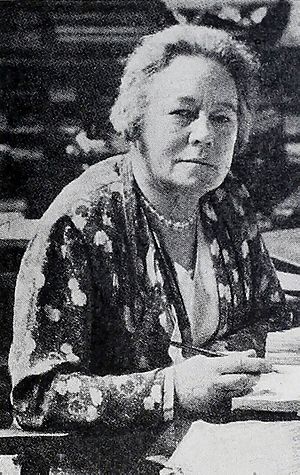Elizabeth M. Kennedy facts for kids
Quick facts for kids
Elizabeth M. Kennedy
|
|
|---|---|

Kennedy, circa 1939
|
|
| Died | 1958 |
| Known for | President of the Women's Engineering Society 1932-34 |
| Scientific career | |
| Institutions | Messrs J. B. Stone & Co. Ltd. |
Elizabeth M. Kennedy was an important woman in engineering and business. She was the president of the Women's Engineering Society (WES) from 1932 to 1934. She worked for a company called Messrs J. B. Stone & Co. in London. She started as a typist and worked her way up to become a managing director. She held this top position until she retired in 1934. Even though she achieved a lot as a woman in business after World War I, she believed that a person's ability was more important than their gender. She felt that both men and women should have chances based on what they could do.
Contents
Elizabeth Kennedy's Career Journey
As a teenager, Elizabeth Kennedy dreamed of becoming a reporter for a newspaper in London. She even got a job at a local paper. However, the editor thought he had hired a young man, so she didn't get to stay.
Working at J. B. Stone & Co.
After that, Kennedy found a job as a typist at Messrs J. B. Stone & Co. This company first made tools for working with wood. Over time, they started making tools for working with metals too.
In 1915, the company became a limited company, and Elizabeth was made Secretary. Soon after, she became the Joint Managing Director, and then the Managing Director. She was known for encouraging women to start at the bottom and work their way up in companies. She helped the company sell important machines like "nibbling machines," which were used to quickly cut sheet metal. Kennedy stayed as Managing Director until she retired in June 1934.
Leading the Women's Engineering Society
Elizabeth Kennedy joined the Women's Engineering Society (WES) in 1925. This group helps women in engineering. She was chosen to be the President of the society in 1932 and again in 1933.
In 1927, she gave a talk called A Business Woman's Trip to America. She also took part in a debate about how important business and technical skills are in engineering. Kennedy argued for the business side, while another engineer, Verena Holmes, argued for the technical side. Kennedy believed that business and technical roles needed to work together. She said that new inventions need money to grow, but also vision and effort to create what people need.
In 1934, when she was leaving her role as president, Kennedy shared her thoughts on the tough economic times after the war. She thought that companies made too many products during and after the war. When these products were no longer needed, companies had to buy them back. This stopped the products from being sold too cheaply and flooding the markets.
Her Travels to America
Elizabeth Kennedy traveled to the United States many times while working for Messrs J. B. Stone & Co. Ltd. She saw America during times of great wealth and also during difficult economic periods.
In her 1927 lecture, A Business Woman's Trip to America, she shared her thoughts on doing business there. She also talked about the role of women and why people should visit. She noticed that America had a strong "spirit of youth" everywhere. She was very impressed by how adventurous Americans were. She said that a person might quit their job in middle age and start something completely new, which was very rare in her own country.
Kennedy also saw a good spirit of cooperation between factory owners and workers. She noted that American business people often had a "cheery word and smile." She also liked that restaurants and hotels treated business men and women the same. She thought this was a great example for the rest of the world. However, she felt that women in industry had more opportunities in the UK than in America. She believed American men tended to keep women "on a pedestal" and didn't see them as serious business partners.
Elizabeth Kennedy's Views on Women Engineers
In her speech to the Women's Engineering Society, Elizabeth Kennedy shared her thoughts on women in engineering. She said she didn't think there was a huge future for women engineers. However, she strongly believed that women were not taking over men's jobs. In her opinion, there shouldn't be separate "men's work" and "women's work." She felt that if a girl was good at engineering, she should go for it, just like a man who is good at designing clothes would become a dress designer.
Kennedy also talked about the challenges for women in the 1930s, especially with family life. She noted that engineering was often seen as a lifelong career. But, many girls at the time didn't expect to work their whole lives. She explained that a boy entering engineering might expect to be a manager or chief engineer by age forty. But a girl might hope not to still be working in business at forty.
Her Final Years
In the Spring of 1958, it was announced that Elizabeth Kennedy had passed away. An article about her death in The Woman Engineer magazine stated that she had "spent her whole life in engineering."
See also
 In Spanish: Elizabeth M. Kennedy para niños
In Spanish: Elizabeth M. Kennedy para niños 
- Women's Engineering Society

